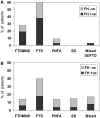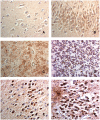Distinct clinical and pathological characteristics of frontotemporal dementia associated with C9ORF72 mutations
- PMID: 22300873
- PMCID: PMC3286329
- DOI: 10.1093/brain/awr355
Distinct clinical and pathological characteristics of frontotemporal dementia associated with C9ORF72 mutations
Abstract
The identification of a hexanucleotide repeat expansion in the C9ORF72 gene as the cause of chromosome 9-linked frontotemporal dementia and motor neuron disease offers the opportunity for greater understanding of the relationship between these disorders and other clinical forms of frontotemporal lobar degeneration. In this study, we screened a cohort of 398 patients with frontotemporal dementia, progressive non-fluent aphasia, semantic dementia or mixture of these syndromes for mutations in the C9ORF72 gene. Motor neuron disease was present in 55 patients (14%). We identified 32 patients with C9ORF72 mutations, representing 8% of the cohort. The patients' clinical phenotype at presentation varied: nine patients had frontotemporal dementia with motor neuron disease, 19 had frontotemporal dementia alone, one had mixed semantic dementia with frontal features and three had progressive non-fluent aphasia. There was, as expected, a significant association between C9ORF72 mutations and presence of motor neuron disease. Nevertheless, 46 patients, including 22 familial, had motor neuron disease but no mutation in C9ORF72. Thirty-eight per cent of the patients with C9ORF72 mutations presented with psychosis, with a further 28% exhibiting paranoid, deluded or irrational thinking, whereas <4% of non-mutation bearers presented similarly. The presence of psychosis dramatically increased the odds that patients carried the mutation. Mutation bearers showed a low incidence of motor stereotypies, and relatively high incidence of complex repetitive behaviours, largely linked to patients' delusions. They also showed a lower incidence of acquired sweet food preference than patients without C9ORF72 mutations. Post-mortem pathology in five patients revealed transactive response DNA-binding protein 43 pathology, type A in one patient and type B in three. However, one patient had corticobasal degeneration pathology. The findings indicate that C9ORF72 mutations cause some but not all cases of frontotemporal dementia with motor neuron disease. Other mutations remain to be discovered. C9ORF72 mutations are associated with variable clinical presentations and pathology. Nevertheless, the findings highlight a powerful association between C9ORF72 mutations and psychosis and suggest that the behavioural characteristics of patients with C9ORF72 mutations are qualitatively distinct. Mutations in the C9ORF72 gene may be a major cause not only of frontotemporal dementia with motor neuron disease but also of late onset psychosis.
Figures



Similar articles
-
Frontotemporal dementia with the C9ORF72 hexanucleotide repeat expansion: clinical, neuroanatomical and neuropathological features.Brain. 2012 Mar;135(Pt 3):736-50. doi: 10.1093/brain/awr361. Brain. 2012. PMID: 22366791 Free PMC article.
-
Clinical and pathological features of familial frontotemporal dementia caused by C9ORF72 mutation on chromosome 9p.Brain. 2012 Mar;135(Pt 3):709-22. doi: 10.1093/brain/awr354. Epub 2012 Feb 17. Brain. 2012. PMID: 22344582 Free PMC article.
-
The clinical and pathological phenotype of C9ORF72 hexanucleotide repeat expansions.Brain. 2012 Mar;135(Pt 3):723-35. doi: 10.1093/brain/awr353. Epub 2012 Feb 1. Brain. 2012. PMID: 22300876
-
The frontotemporal dementia-motor neuron disease continuum.Lancet. 2016 Aug 27;388(10047):919-31. doi: 10.1016/S0140-6736(16)00737-6. Epub 2016 Mar 14. Lancet. 2016. PMID: 26987909 Review.
-
The clinical and pathological phenotypes of frontotemporal dementia with C9ORF72 mutations.J Neurol Sci. 2013 Dec 15;335(1-2):26-35. doi: 10.1016/j.jns.2013.09.013. Epub 2013 Sep 17. J Neurol Sci. 2013. PMID: 24090760 Review.
Cited by
-
Psychotic symptoms in frontotemporal dementia.Curr Neurol Neurosci Rep. 2015 Jul;15(7):46. doi: 10.1007/s11910-015-0567-8. Curr Neurol Neurosci Rep. 2015. PMID: 26008815 Review.
-
Grey and white matter changes across the amyotrophic lateral sclerosis-frontotemporal dementia continuum.PLoS One. 2012;7(8):e43993. doi: 10.1371/journal.pone.0043993. Epub 2012 Aug 29. PLoS One. 2012. PMID: 22952843 Free PMC article.
-
Cognition and behaviour in frontotemporal dementia with and without amyotrophic lateral sclerosis.J Neurol Neurosurg Psychiatry. 2020 Dec;91(12):1304-1311. doi: 10.1136/jnnp-2020-323969. Epub 2020 Oct 14. J Neurol Neurosurg Psychiatry. 2020. PMID: 33055142 Free PMC article.
-
Altered network properties in C9ORF72 repeat expansion cortical neurons are due to synaptic dysfunction.Mol Neurodegener. 2021 Mar 4;16(1):13. doi: 10.1186/s13024-021-00433-8. Mol Neurodegener. 2021. PMID: 33663561 Free PMC article.
-
Distinct TDP-43 pathology in ALS patients with ataxin 2 intermediate-length polyQ expansions.Acta Neuropathol. 2012 Aug;124(2):221-30. doi: 10.1007/s00401-012-0985-5. Epub 2012 Apr 21. Acta Neuropathol. 2012. PMID: 22526021 Free PMC article.
References
-
- Baborie A, Griffiths TD, Jaros E, McKeith IG, Burn DJ, Richardson A, et al. Pathological correlates of frontotemporal lobar degeneration in the elderly. Acta Neuropathol. 2011;121:365–71. - PubMed
-
- Bak TH, O'Donovan DG, Xuereb JH, Boniface S, Hodges JR. Selective impairment of verb processing associated with pathological changes in Brodmann areas 44 and 45 in the motor neurone disease-dementia-aphasia syndrome. Brain. 2001;124:103–20. - PubMed
-
- Baker M, Mackenzie IRA, Pickering-Brown SM, Gass J, Rademakers R, Lindholm C, et al. Mutations in Progranulin cause tau-negative frontotemporal dementia linked to chromosome 17. Nature. 2006;442:916–9. - PubMed
-
- Bathgate D, Snowden JS, Varma A, Blackshaw A, Neary D. Behaviour in frontotemporal dementia: a comparison with Alzheimer's disease and vascular dementia. Acta Neurol Scand. 2001;103:367–78. - PubMed
Publication types
MeSH terms
Substances
Grants and funding
LinkOut - more resources
Full Text Sources
Other Literature Sources
Molecular Biology Databases

